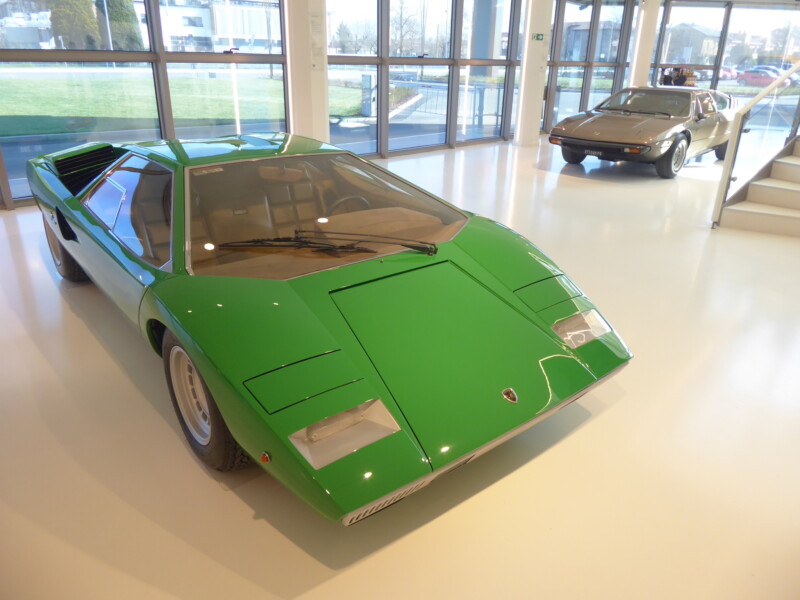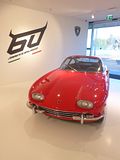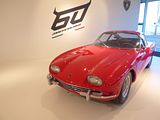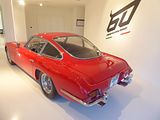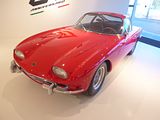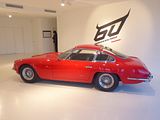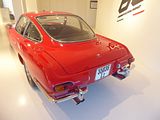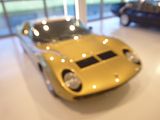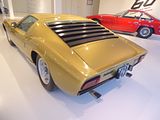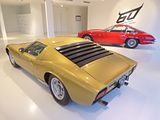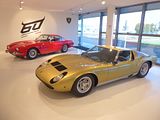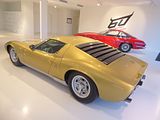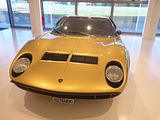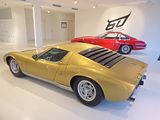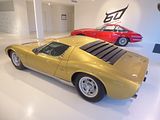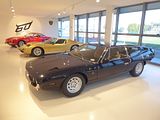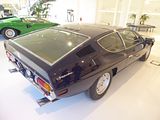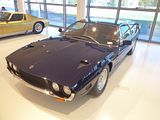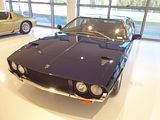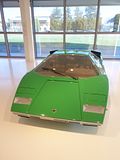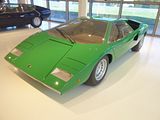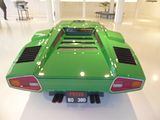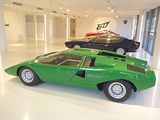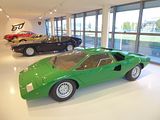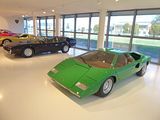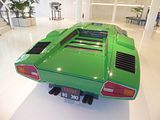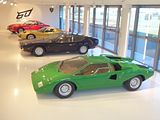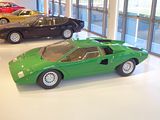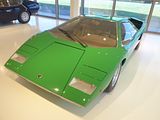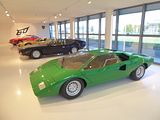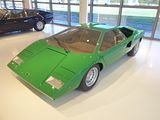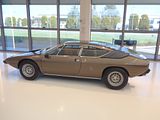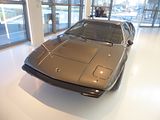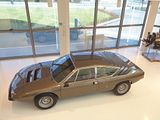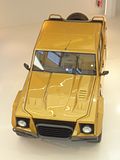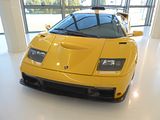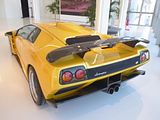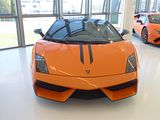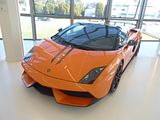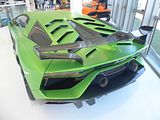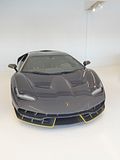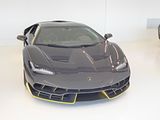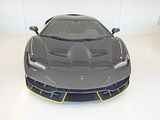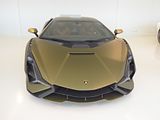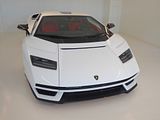Although there had been Lamborghini products before 1963, with an array of tractors and some surprising items such as fridges and air conditioning units, the Lamborghini company we all think of started in 1963 with the launch of Ferrucio’s first car, the 350GT. There will be all manner of events during 2023 to mark the 60th anniversary of one of the world’s most recognised brands. Not surprisingly, the factory museum did not want to miss out and so early in the year they announced that they had produced a special display to mark this 60th year. That was all the encouragement I needed to make a return visit, to go and see it. I’ve made the visit to Sant’Agata da Bolognese, where you will find the factory and the associated museum a number of times before. It really is in the middle of a very rural area, so you can see why making tractors was a good business proposition. But it is also only a few km from Modena and the A1 autostrada which links Milano with Roma, so it is quite easy to gets part in and finished cars out.



The museum is at the front of the factory site and comprises a modern 2 storey building, with a lot of space, but a conscious decision not to cram it with cars, even though the factory collection must now be quite extensive. So changing the exhibits periodically means that there is a good reason to go back for another look. This museum is popular, so although there are no people in the photos, I can tell you that it was pretty busy and I had to be supremely patient for them to move out of the way! Enjoy the cars that Lamborghini selected to represent their first 60 years of car production.
350GT
It is well documented that the whole reason for Ferruccio Lamborghini’ diversification into producing cars was after a stormy meeting at Maranello when he confronted Enzo Ferrari with a series of issues with his Ferrari. Enzo was far from sympathetic, so Lamborghini resolved to produce his own car, and that it would be “better” in every way. The 350 GT was the result. Production started in May 1964, after its well-received debut at the March 1964 Geneva Show. After the testing of his prototype Lamborghini engine in May 1963, Giotto Bizzarrini left the company, and the following month Ferruccio Lamborghini assigned Gian Paolo Dallara—with the assistance of Paolo Stanzani and Bob Wallace—the task of developing a production version of the grand tourer. Dallara and Stanzani quickly realised that the Lamborghini 350GTV was not properly designed for mass production, so they proceeded along parallel lines: it was necessary to detune the original Bizzarrini engine; and to redesign the original Bizzarrini chassis for street use. The original Bizzarrini-designed 3.5 litre V12 was essentially a race motor, potentially developing 400 hp at 11,000rpm. In order to fit his grand touring car with a smoother, more pleasant, longer-lasting engine, that was “good for 40,000 hard miles between services” Ferruccio had Dallara and Wallace detune a version of this prototype “GTV” motor for street use. This first “detuned” L350 engine was tested on October 3, 1963. The result was a very capable 270 bhp power plant that could reach 254 km/h (158 mph). While this 350 GT design work continued, the prototype was rushed to completion for the upcoming October 26 press meeting and the subsequent inauguration of the Turin Auto Show on the 30th. The Lamborghini 350GTV was shown at the Turin Auto Show with the original Bizzarrini “racing” V-12 engine—with its downdraft webers, rear distributors, etc.—displayed alongside as it was not “adapted to the chassis.” The car was a “non-runner” with the suspension arms simply tack-welded in place and the engine not installed. Lukewarm reaction to the car caused Ferruccio to postpone plans for immediate production and move on to the new 350 GT design. In March 1964, only 5 months after the debut of the GTV in Turin, the “redesigned GTV”—now called the 350 GT—was debuted at the Geneva Auto Show It was greeted with sufficient enthusiasm that Ferruccio decided to proceed with production at Sant’Agata in May 1964. The production 350 GT had an all-aluminium alloy V12 engine mated to a five-speed ZF manual transmission. It had an aluminium body (some had steel bodies), a Salisbury differential, four-wheel independent suspension, and vacuum servo-assisted Girling disc brakes all round. The 350 GT could accelerate from 0 to 100 km/h in 6.8 seconds, and from 0 to 100 mph in 16.3 seconds, and go on to reach a top speed of 158 mph. The 350 GT shared a number of features with the 350 GTV prototype, including a four-wheel independent suspension, quad-cam V12, and an aluminium body. A number of revisions and refinements were made due to the suggestions of the Neri and Bonacini racing development shop, and test driver Bob Wallace. Fixed headlights replaced the prototype’s rotationally hidden variety, and twin-barrel side-draught Weber 40 DCOE 2 carburettors reduced the height of the engine, thereby negating the clearance problems of the GTV prototype, and giving the car the exceptionally low hood line Ferruccio desired. As was the case with the motor, Bizzarrini’s GTV “racing” chassis design was the basis of Dallara’s 350 GT “street” chassis. Using far heavier materials, Dallara created an extremely strong chassis from square-section tubing which provided easy entry and exit through the doors, aided in the quietness of the car, and provided a solid platform on which to mount the body, much like the Aston Martin DB4. The suspension was fully independent, with unequal-length wishbones and concentric coil-spring-damper units. The rear suspension wishbones were offset towards the spring mountings to resist driving and braking torque, which provided superior handling. Quality control of the early 3.5 litre engines was very high. Each one underwent tests for 24 hours on a Schenk Walge dynamometer, being run for the first 12 hours under electric power, and then with gasoline at increasing speeds. A detailed analysis was made of its behaviour before installation in the car for at least 500 km of mixed-test running by Wallace. The manufacture of the bodies was entrusted to Touring of Milan, who used their patented Superleggera method of construction to fix aluminium alloy panels directly to a tubular structure. The first 350 GT frame was fabricated by Neri and Bonacini, who continued to act as Lamborghini’s chassis supplier until production of the 350 GT was underway, when the job was turned over to Marchesi. Chassis and bodies were mated at Touring, which then delivered the complete assemblies—with even the bumpers in place—to the Lamborghini factory. The first 350 GT chassis and body, delivered to the Lamborghini factory on March 9, 1964, was named No. 101 (Touring No. 17001). That same month No. 101 debuted at the Geneva show. The first customer delivery of a 350 GT was No. 104 (Touring No. 17004), delivered on July 31, 1964. Lamborghini produced 120 of their 350 GTs before replacing it with the larger-engined Lamborghini 400 GT in 1966. Many 350 GTs were subsequently fitted with the larger, 4.0 litre, engine.
MIURA
Some will say was the first true supercar. For sure, this car, produced between 1966 and 1973, is widely considered to have instigated the trend of high performance, two-seater, mid-engined sports cars. When released, it was the fastest production road car available. The Miura was originally conceived by Lamborghini’s engineering team, Gian Paolo Dallara, Paolo Stanzani, and Bob Wallace who in 1965 put their own time into developing a prototype car known as the P400. The engineers envisioned a road car with racing pedigree – one which could win on the track and be driven on the road by enthusiasts. The three men worked on its design at night, hoping to convince Lamborghini such a vehicle would neither be too expensive nor distract from the company’s focus. When finally brought aboard, Lamborghini gave his engineers a free hand in the belief the P400 was a potentially valuable marketing tool, if nothing more. The car featured a transversely-mounted mid-engine layout, a departure from previous Lamborghini cars. The V12 was also unusual in that it was effectively merged with the transmission and differential, reflecting a lack of space in the tightly-wrapped design. The rolling chassis was displayed at the Turin Salon in 1965. Impressed showgoers placed orders for the car despite the lack of a body to go over the chassis. Bertone was placed in charge of styling the prototype, which was finished just days before its debut at the 1966 Geneva motor show. Curiously, none of the engineers had found time to check if the engine would fit inside its compartment. Committed to showing the car, they decided to fill the engine bay with ballast and keep the car locked throughout the show, as they had three years earlier for the début of the 350GTV. Sales head Sgarzi was forced to turn away members of the motoring press who wanted to see the P400’s power plant. Despite this setback, the car was the highlight of the show, immediately boosting stylist Marcello Gandini’s reputation. The favourable reaction at Geneva meant the P400 was to go into production by the following year. The name “Miura”, a famous type of fighting bull, was chosen, and featured in the company’s newly created badge. The car gained the worldwide attention of automotive enthusiasts when it was chosen for the opening sequence of the original 1969 version of The Italian Job. In press interviews of the time company founder Ferruccio Lamborghini was reticent about his precise birth date, but stressed that he was born under the star sign Taurus the bull. Early Miuras, known as P400s (for Posteriore 4 litri), were powered by a version of the 3.9 litre Lamborghini V12 engine used in the 400GT at the time, only mounted transversely and producing 350 hp. Exactly 275 P400 were produced between 1966 and 1969 – a success for Lamborghini despite its then-steep price. Taking a cue from the Mini, Lamborghini formed the engine and gearbox in one casting. Its shared lubrication continued until the last 96 SVs, when the case was split to allow the correct oils to be used for each element. An unconfirmed claim holds the first 125 Miuras were built of 0.9 mm steel and are therefore lighter than later cars. All cars had steel frames and doors, with aluminium front and rear skinned body sections. When leaving the factory they were originally fitted with Pirelli Cinturato 205VR15 tyres (CN72). The P400S Miura, also known as the Miura S, made its introduction at the Turin Motorshow in November 1968, where the original chassis had been introduced three years earlier. It was slightly revised from the P400, with the addition of power windows, bright chrome trim around external windows and headlights, new overhead inline console with new rocker switches, engine intake manifolds made 2 mm larger, different camshaft profiles, and notched trunk end panels (allowing for slightly more luggage space). Engine changes were reportedly good for an additional 20 hp. Other revisions were limited to creature comforts, such as a locking glovebox lid, a reversed position of the cigarette lighter and windshield wiper switch, and single release handles for front and rear body sections. Other interior improvements included the addition of power windows and optional air conditioning, available for US$800. About 338 P400S Miura were produced between December 1968 and March 1971. One S #4407 was owned by Frank Sinatra. Miles Davis also owned one, which he crashed in October 1972 under the influence of cocaine, breaking both ankles. The last and most famous Miura, the P400SV or Miura SV featured different cam timing and altered carburettors. These gave the engine an additional 15 hp to a total of 380 hp. The last 96 SV engines had a split sump. The gearbox now had its lubrication system separate from the engine, which allowed the use of the appropriate types of oil for the gearbox and the engine. This also alleviated concerns that metal shavings from the gearbox could travel into the engine with disastrous and expensive results and made the application of an optional LSD far easier. The SV can be distinguished from its predecessors from its lack of “eyelashes” around the headlamps, wider rear wings to accommodate the new 9-inch-wide rear wheels and Pirelli Cinturato tyres, and different taillights. 150 SVs were produced. The car seen here is an SV, as can be identified by the absence of the “eyelashes” around the headlights.
ESPADA
The Espada, a 4-seat grand touring coupé, arrived in 1968. The car was designed by Marcello Gandini at Bertone. Gandini drew inspiration and cues from two of his Bertone show cars from 1967, the Lamborghini Marzal and the Jaguar Piraña. The name “Espada” means “sword” in Spanish, referring to the sword that the Torero uses to kill the bull in the Corrida. During its ten years in production the car underwent some changes, and three different series were produced. These were the S1 (1968–1970), the S2 (1970–1972) and the S3 (1972–1978). Each model featured interior redesigns, while only minor details were changed on the exterior. The Espada was launched at the 1968 Geneva Motor Show. The original design of the dashboard was inspired by the Marzal concept car, and featured octagonal housings for the main instruments, topped by an additional binnacle for the secondary gauges. Wheels were Campagnolo alloys on knock-off hubs, of the same design seen on the Miura. The tail lights were the same units mounted on the first series Fiat 124 Sport Coupé. 186 were made up until January 1970. At the 1970 Brussels Motor Show Lamborghini unveiled the Espada S2. Outside the only change was the deletion of the grille covering the vertical glass tail panel. Inside changes were more radical: all-new dashboard, centre console and steering wheel were installed. The instrument binnacle was of a more conventional rectangular shape, with round gauges. A wood-trimmed fascia extended along the entire width of the dashboard. Power output increased to 350 PS (345 bhp) due to a higher 10.7:1 compression ratio; the brakes were upgraded to vented Girling discs. Power steering was offered as an option. 575 Series II Espada were made, making it the most popular and desirable variant. The Espada S3 was launched in 1972. Its 3.9 litre V12 engine produced 325 PS (321 bhp) With the second redesign the dashboard changed to a aluminium-trimmed cockpit that kept all instruments and most controls (including the radio) within easy reach of the driver. Newly designed wheels on five-stud hubs replaces the earlier knock-off wider wheels fitted with Pirelli Cinturato 215/70WR15 CN12 tyres, making the Espada S3 instantly recognisable; other exterior changes included the square instead of hexagonal mesh grille and tail lights from the Alfa Romeo 2000 replacing the previous Fiat-sourced ones. In 1974 a Borg Warner automatic transmission became available. From 1975 large impact bumpers had to be installed to meet United States safety requirements; some people consider cars produced with them as a separate fourth series, but Lamborghini did not officially change the model designation. In total, 1217 Espadas were made, making it the most successful Lamborghini model until the expansion of Countach production in the mid-1980s.
COUNTACH
Which small boy (and perhaps car loving girl) did not lust after a Countach back in the 1970s and 1980s. A dramatic looking car, this was the stuff of dreams that you would only ever see at the London or NEC Motor Shows. Countach first made an appearance, as a concept in 1971, but it was 1973 before the production car made its debut, and despite unfortunate timing with fuel shortages and a recession, and a number of financial problems for its maker, the car sold well throughout its production life. The Countach entered production as the LP400 with a 3929 cc engine delivering 370 hp. The first production Countach was delivered to an Australian in 1974. Externally, little had altered from the final form of the prototype except at the rear, where conventional lights replaced the futuristic light clusters of the prototype. The styling had become rather more aggressive than Gandini’s original conception, with the required large air scoops and vents to keep the car from overheating, but the overall shape was still very sleek. The original LP400 rode on the quite narrow tyres of the time, but their narrowness and the slick styling meant that this version had the lowest drag coefficient of any Countach model. The emblems at the rear simply read “Lamborghini” and “Countach”, with no engine displacement or valve arrangement markings as is found on later cars. By the end of 1977, the company had produced 158 Countach LP400s. In 1978, a new LP400 S model was introduced. Though the engine was slightly downgraded from the LP400 model (350 bhp), the most radical changes were in the exterior, where the tyres were replaced with 345/35R15 Pirelli P7 tyres; the widest tyres available on a production car at the time, and fibreglass wheel arch extensions were added, giving the car the fundamental look it kept until the end of its production run. An optional V-shaped spoiler was available over the rear deck, which, while improving high-speed stability, reduced the top speed by at least 16 km/h (10 mph). Most owners ordered the wing. The LP400 S handling was improved by the wider tires, which made the car more stable in cornering. Aesthetically, some prefer the slick lines of the original, while others prefer the more aggressive lines of the later models, beginning with the LP400 S. The standard emblems (“Lamborghini” and “Countach”) were kept at the rear, but an angular “S” emblem was added after the “Countach” on the right side. 1982 saw another improvement, this time giving a bigger, more powerful 4754 cc engine. The bodywork was unaltered, however the interior was given a refresh. This version of the car is sometimes called the 5000 S, which may cause confusion with the later 5000 QV. 321 of these cars were built. Two prototypes of the 1984 Countach Turbo S were built by Lamborghini, of which one is known to exist. The Turbo S weighed 1,515 kg (3,340 lb), while its 4.8 litre twin-turbo V12 had a claimed maximum power output of 758 PS and a torque output of 876 N·m (646 lb·ft), giving the car an acceleration of 0–100 km/h (0–62 mph) in 3.7 seconds and a top speed of 335 km/h (208 mph). A turbo adjuster, located beneath the steering wheel, could be used to adjust the boost pressure from 0.7 bar to 1.5 bar at which the engine performed its maximum power output. The Turbo S has 15″ wheels with 255/45 tyres on the front and 345/35 on the rear. In 1985 the engine design evolved again, as it was bored and stroked to 5167 cc and given four valves per cylinder—quattrovalvole in Italian, hence the model’s name, Countach 5000 Quattrovalvole or 5000 QV in short. The carburettors were moved from the sides to the top of the engine for better breathing—unfortunately this created a hump on the engine deck, reducing the already poor rear visibility to almost nothing. Some body panels were also replaced by Kevlar. In later versions of the engine, the carburettors were replaced with fuel injection. Although this change was the most notable on the exterior, the most prominent change under the engine cover was the introduction of fuel injection, with the Bosch K-Jetronic fuel injection, providing 414 bhp, rather than the six Weber carburettors providing 455 bhp. As for other markets, 1987 and 1988 model Quattrovalvoles received straked sideskirts. 610 cars were built. Seen here is one of the early Countach LP400 models.
URRACO
Lamborghini had been toying for some time with the idea of a smaller and cheaper car, powered by a V8 engine, to rival the smaller Ferraris, and the result, the Urraco, was first seen at the 1970 Turin Show. It was styled by Marcello Gandini, and engineered by Paolo Stanzani. It was launched with a 2.5 litre V8 engine, engineered to be cheaper to build, with belt-driven camshafts, situated within a steel monocoque structure suspended on McPherson struts. It reached the market before the rival Maserati Merak and Ferrari 308 GT4 Dino, which should have given it a big advantage. But it did not. For a start, it was deemed not powerful enough, so even before the difficulties of the late 1973 Fuel Crisis made things difficult, the car did not sell well at all. The solution was to add more power, and this came when the engine was enlarged to 3 litres, with four chain-driven cams, which took power from 220 bhp to 265 bhp. A roll-hoop across the back of the cabin improved rigidity, and more powerful brakes were fitted. It sold better, though never in the sort of volume that had been anticipated, and the addition of an Italian market tax special P200 did not help much, either. Just 66 of these were built, whereas 520 of the original P250 models found buyers, and 190 of the more powerful P300s added to the total before production ceased in 1979. The story did not quite end there, as in 1976 a heavily revised version, with removable targa roof panels, appeared, called the Silhouette, and both were replaced by the Jalpa in the 1980s, though neither of these sold as well as the Urraco.
LM002
Although it was not introduced until 1986, its origins go back nearly a decade before that. Lamborghini built its first military vehicle, a prototype vehicle codenamed the “Cheetah”, in 1977. Lamborghini had designed the vehicle with hopes of selling it to companies in the oil exploration and production industry. The original Cheetah prototype had a rear-mounted Chrysler V8 engine. The only finished prototype was never tested by the US military, only demonstrated to them by its designer, Rodney Pharis. It was later sold to Teledyne Continental Motors by MTI and is apparently still in the US. This led Lamborghini to develop the LM001, which was very similar to the Cheetah, but had an AMC V8 engine. It was finally determined that the engine being mounted in the rear caused too many unfavourable handling characteristics in an offroad vehicle, and the LMA002 was built with an entirely new chassis, moving the engine (now the V12 out of the Lamborghini Countach) to the front. After much testing and altering of the prototype, it was finally given a serial number and became the first LM002. The production model was unveiled at the Brussels Auto Show in 1986. It was dubbed the “Rambo-Lambo”. Civilian models were outfitted with a full luxury package, including full leather trim, tinted power windows, air conditioning, and a premium stereo mounted in a roof console. In order to meet the vehicle’s tire needs, Lamborghini commissioned Pirelli to create the Pirelli Scorpion tires with custom, run-flat tread designs. These were made specifically for the LM and were offered in two different tread designs, one for mixed use and the other for sand use only. These tyres could be run virtually flat without risk and could handle the desert heat, the loading, and the speeds of the LM. The LM002 was fitted with a 290-litre fuel tank. For those requiring even more power, the Lamborghini L804 type 7.2 litre marine V12, more commonly found in Class 1 offshore powerboats, could be specified. In 1988, Lamborghini sent an LM002 to a team of special engineers with the intention of making it capable of participating in the Paris Dakar Rally. They stripped it of anything that added unnecessary weight and gave it an upgraded suspension, engine modifications which brought it to 600 hp, full roll cage, plexiglas windows, and GPS equipment. Funding ran out before it could officially be entered in competition, although it did participate in the Rallye des Pharaohs in Egypt and another in Greece, both times driven by Sandro Munari.
URUS
Commercially the most successful Lamborghini by some margin, I guess the Urus has to have a place here. The name comes from the urus, the ancestor of modern domestic cattle, also known as the aurochs.[Previously, Lamborghini had trademarked the name “Urus” before the introduction of the Lamborghini Estoque at the 2008 Paris Motor Show, and automotive news blogs Jalopnik and Autoblog believed that the name would be applied to what was eventually found to be the Estoque. The Lamborghini Urus concept was unveiled at the 2012 Beijing Auto Show on 23 April 2012. Later, the SUV was also shown at Pebble Beach in 2012. Powered by a 5.2-litre V10 engine shared with the Gallardo, the engine generated a theoretical maximum power output of 600 PS (592 bhp) and was accompanied with an all-wheel-drive system. The sharp-lined exterior design of the SUV takes heavy influence from the company’s V12 flagship, the Aventador. The production Lamborghini Urus is a luxury SUV which was introduced in December 2017, the first Lamborghini SUV and five-door vehicle in the modern era (under the ownership of Volkswagen Group), and the second SUV in the brand’s history after the LM002, which was produced between 1986 and 1993. Built on the Volkswagen Group MLB Evo platform, the Urus shares many components with other Volkswagen Group luxury SUVs, such as the Audi Q7, Bentley Bentayga, Porsche Cayenne, and Volkswagen Touareg. With a top speed of 305 km/h (190 mph), the Urus is considered as one of the fastest production SUVs in the world. Production of the new Urus started at Lamborghini’s refreshed Sant’Agata facility, ahead of first deliveries in early 2018 with a targeted sales volume of around 3,500 a year. However, Lamborghini had to expand their factory in Sant’Agata Bolognese to meet the higher demand. In July 2020, the company announced the 10,000th unit of the Urus. In 2022, Lamborghini hit a major milestone by producing 20,000 of these SUVs, making the Urus the company’s best-selling model in the shortest time.
DIABLO
At a time when the company was financed by the Swiss-based Mimran brothers, Lamborghini began development of what was codenamed Project 132 in June 1985 as a replacement for the Countach model. The brief stated that its top speed had to be at least 315 km/h (196 mph). The design of the car was contracted to Marcello Gandini, who had designed its two predecessors. When Chrysler bought the company in 1987, providing money to complete its development, its management was uncomfortable with Gandini’s designs and commissioned its design team in Detroit to execute a third extensive redesign, smoothing out the trademark’s sharp edges and corners of Gandini’s original design, and leaving him famously unimpressed. In fact, Gandini was so disappointed with the “softened” shape that he would later realise his original design in the Cizeta-Moroder V16T. The car became known as the Diablo, carrying on Lamborghini’s tradition of naming its cars after breeds of fighting bulls. The Diablo was named after a ferocious bull raised by the Duke of Veragua in the 19th century, famous for fighting an epic battle with ‘El Chicorro’ in Madrid on July 11, 1869 In the words of Top Gear presenter Jeremy Clarkson, the Diablo was designed “solely to be the biggest head-turner in the world.” The Diablo was presented to the public for sale on January 21, 1990. Its power came from a 5.7 litre 48-valve version of the existing Lamborghini V12 featuring dual overhead cams and computer-controlled multi-point fuel injection, producing a maximum output of 499 PS and 580 N·m (428 lb/ft) of torque. The vehicle could reach 100 km/h in about 4.5 seconds, with a top speed of 202 mph. The Diablo was rear-wheel drive and the engine was mid-mounted to aid its weight balance. The Diablo came better equipped than the Countach; standard features included fully adjustable seats and steering wheel, electric windows, an Alpine stereo system, and power steering from 1993 onwards. Anti-lock brakes were not initially available, although they would eventually be used. A few options were available, including a custom-moulded driver’s seat, remote CD changer and subwoofer, rear spoiler, factory fitted luggage set and an exclusive Breguet clock for the dash. The Diablo VT was introduced in 1993. Although the VT differed from the standard Diablo in a number of ways, by far the most notable change was the addition of all wheel drive, which made use of a viscous centre differential (a modified version of LM002’s 4WD system). This provided the new nomenclature for the car (VT stands for viscous traction). The new drivetrain could direct up to 25% of the torque to the front wheels to aid traction during rear wheel slip, thus significantly improving the handling characteristics of the car. Other improvements debuting on the VT included front air intakes below the driving lamps to improve brake cooling, larger intakes in the rear arches, a more ergonomic interior with a revised dashboard, electronically adjustable dampers, four-piston brake calipers, power steering, and minor engine refinements. Many of these improvements, save the four-wheel drive system, soon transferred to the base Diablo, making the cars visually nearly identical. Further updates would follow before the car gave way to the Murcielago in 2001. The Diablo sold in greater numbers than its predecessor with 2898 examples being made during its 11 year production life. The example seen here was a GT, one of the late cars, with the earlier covered headlights now replaced – following a regulation change – by the glass-covered ones.
MURCIELAGO
In its turn, the Diablo gave way to the Murcielago in 2001. Taking its name from the Spanish for “bat”, this was Lamborghini’s first new design in eleven years and more importantly, the brand’s first new model under the ownership of German parent company Audi, which was manifest in a much higher level of quality and reliability. The Murcielago was styled by Peruvian-born Belgian Luc Donckerwolke, Lamborghini’s head of design from 1998 to 2005. Initially it was only available as a Coupe. The Murciélago was an all-wheel drive, mid-engined supersports car. With an angular design and an exceptionally low slung body, the highest point of the roof is just under 4 feet above the ground. One of the vehicle’s most distinguishing features are its scissor doors. which lends to the extreme image. First-generation Murciélagos, produced between 2001 and 2006, were powered by a Lamborghini V12 that traces its roots back to the company’s beginnings in the 1960s. The rear differential is integrated with the engine itself, with a viscous coupling centre differential providing drive to the front wheels. Power is delivered through a 6-speed manual transmission. The Murciélago suspension uses an independent double-wishbone design, and bodywork features carbon fiber, steel and aluminium parts. The rear spoiler and the active air intakes integrated into the car’s shoulders are electromechanically controlled, deploying automatically only at high speeds in an effort to maximise both aerodynamic and cooling efficiency. The first generation cars were produced between 2001 and 2006, and known simply as Murciélago, sometimes Murciélago VT. Their V12 engines produced just under 580 PS (572 hp), and powered the car to 100 km/h (62 mph) in 3.8 seconds. Subsequent versions incorporated an alphanumeric designation to the name Murciélago, which indicated their engine configuration and output. However, the original cars are never referred to as “LP 580s”. The Murciélago Roadster was introduced in 2004. Primarily designed to be an open top car, it employed a manually attached soft roof as cover from adverse weather, but a warning on the windshield header advised the driver not to exceed 100 mph (160 km/h) with the top in place. The designer used the B-2 stealth bomber, the Wally 118 WallyPower yacht, and architect Santiago Calatrava’s Ciutat de les Arts i les Ciències in Valencia, Spain as his inspiration for the roadster’s revised rear pillars and engine cover. In March 2006, Lamborghini unveiled a new version of its halo car at the Geneva Motor Show: the Murciélago LP 640. The new title incorporated the car’s name, along with an alphanumeric designation which indicated the engine’s orientation (Longitudinale Posteriore), along with the newly updated power output. With displacement now increased to 6.5 litres, the new car made 640 PS ( 631 hp) at 8000 rpm. The Murciélago’s exterior received a minor facelift. Front and rear details were revised, and side air intakes were now asymmetrical with the left side feeding an oil cooler. A new single outlet exhaust system incorporated into the rear diffuser, modified suspension tuning, revised programming and upgraded clutch for the 6-speed “e-Gear” automated sequential transmission with launch control rounded out the performance modifications. Interior seating was also re-shaped to provide greater headroom, and a new stereo system formed part of the updated dashboard. Optional equipment included Carbon fibre-reinforced Silicon Carbide (C/SiC) ceramic composite brakes, chrome paddle shifters and a glass engine cover. At the 2006 Los Angeles Auto Show, Lamborghini announced that the roadster version of the Murciélago would also be updated to LP 640 status. At the 2009 Geneva Motor Show, Lamborghini unveiled the ultimate version of the Murciélago, the LP 670–4 SuperVeloce. The SV moniker had previously appeared on the Diablo SV, and Miura. SV variants are more extreme and track-oriented, and are released at the end of each model’s production run. The SuperVeloce’s V12 produced 670 PS (661 hp) at 8000 rpm and 660 N·m (490 lbf·ft) of torque at 6500 rpm, thanks to revised valve timing and upgraded intake system. The car’s weight was also reduced by 100 kg (220 lb) through extensive use of carbon fibre inside and out. A new lighter exhaust system was also used. As a result of the extensive weight loss, the SV had a power-to-weight ratio of 429 bhp/ton. Also standard were the LP 640’s optional 15-inch carbon-ceramic disc brakes with 6 piston calipers. The original production plan for the SV was limited to 350 cars, , but in fact only 186 LP 670-4s were produced before the factory had to make room for the new Aventador production line. Numbered cars 1–350 do not represent the order in which cars were manufactured. Only 5-6 were made with manual transmission. Production of the Murciélago ended on November 5, 2010, with a total run of 4,099 cars. Its successor, the Aventador, was released at the 2011 Geneva Motor Show. Seen here was an SV.
GALLARDO
The Lamborghini Gallardo is a sports car built by the Italian automotive manufacturer Lamborghini from 2003 to 2013. Named after a famous breed of fighting bull, the V10 powered Gallardo has been Lamborghini’s sales leader and stable-mate to a succession of V12 flagship models—first to the Murciélago (4,099 built between 2001 and 2010), then to the current flagship, the Aventador. The first generation of the Gallardo was powered with an even firing 4,961 cc (5.0 L) 90 degree V10 engine generating a maximum power output of 500 PS at 7500 rpm and 510 Nm (376 lb/ft) of torque at 4500 rpm. The Gallardo was offered with two choices of transmission; a conventional (H-pattern) six-speed manual transmission, and a six-speed electro-hydraulically actuated single-clutch automated manual transmission that Lamborghini called “E-gear”. The “E-gear” transmission provides gear changes more quickly than could be achieved through a manual shift. The driver shifts up and down via paddles behind the steering wheel, but can also change to an automatic mode via the gear selector located in place of the gear shift lever. The vehicle was designed by Luc Donckerwolke and was based on the 1995 Calà prototype designed by Italdesign Giugiaro. For the 2006 model year (launched in late 2005), Lamborghini introduced many changes to the car to counter some criticisms garnered from the press and owners. The exhaust system was changed to a more sporty one (including a flap to make it quieter during city driving), the suspension was revised, a new steering rack was fitted, the engine power was increased by 20 PS to a maximum of 520 PS and the biggest change was overall lower gearing ratios, especially in 1st to 5th gear. These changes gave the car a much better performance than the original and were also included in the limited edition Gallardo SE. The convertible variant of the Gallardo, called the Gallardo Spyder, was unveiled at the Los Angeles Auto Show in January 2006. It was considered by the company to be an entirely new model, with the engine having a power output of 520 PS (382 kW; 513 hp) and a low-ratio six-speed manual transmission. The Spyder has a retractable soft-top. At the 2007 Geneva Auto Show, Lamborghini unveiled the Gallardo Superleggera. The name paid tribute to the construction style of the first Lamborghini production model, the 350 GT, designed and built by Carrozzeria Touring and its emphasis on weight reduction. The Superleggera is lighter than the base model by 100 kg (220 lb) due to the use of carbon fibre panels for the rear diffuser, undertray, the rearview-mirror housings, the interior door panels, the central tunnel, engine cover; titanium wheel nuts and carbon fibre sports seats. The engine power was uprated by 10 PS courtesy of an improved intake, exhaust and ECU for a total power output of 530 PS. The 6-speed E-Gear transmission was standard on US spec models with the 6-speed manual transmission offered as a no cost option. Production of the Superleggera amounted to 618 units worldwide. Presented at the 2008 Geneva Motor Show, the Gallardo LP 560-4 was a significant update of the Gallardo, powered by a new, uneven firing5,200 cc V10 engine that produces 560 PS at 8,000 rpm and 540 Nm (398 lb/ft) of torque at 6,500 rpm. Featuring “Iniezione Diretta Stratificata” direct fuel injection system to improve efficiency; fuel consumption and CO2 emissions have been reduced by 18% despite the increase in performance. The car was redesigned, inspired by the Murciélago LP 640 and Reventón. The new engine, 40 PS more powerful than in the previous car, comes with two transmission choices: a 6-speed manual or 6-speed E-gear, the latter of which was revised to offer a Corsa mode which makes 40% quicker shifts than before and decreases traction control restrictions, a Thrust Mode launch control system was also added. Accompanied with a 20 kg (44 lb) weight reduction. All the improvements add up to a claimed performance of 0-100 km/h (62 mph) in 3.7 seconds, 0-200 km/h (124 mph) of 11.8 and a top speed of 325 km/h (202 mph). The MSRP base price was $198,000 in the US and £147,330 (including NavTrak vehicle tracking system and delivery package) in the UK. The first US car was sold in the 16th Annual Race to Erase MS charity auction for $198,000 to former True Religion Jeans co-founder/co-creator Kymberly Gold and music producer Victor Newman. The Lamborghini Gallardo LP 560-4 Spyder was unveiled at the 2008 LA Auto Show.as the replacement for the previous Gallardo Spyder. It is the convertible model of the Gallardo LP 560-4 and as such possess all of its features like the new uneven firing 5.2 L V10 engine, improved E-gear transmission and 20 kg (44 lb) weight reduction. Performance has been improved to 0-100 km/h (62 mph) in 3.8 seconds, 0-200 km/h (124 mph) of 13.1 and a top speed of 324 km/h (201 mph) In March 2010, Lamborghini announced the release of the Gallardo LP 570-4 Superleggera, a lightweight and more powerful version of the Gallardo LP 560–4 in the same vein as the previous Superleggera. With carbon fibre used extensively inside and out to reduce weight to just 1,340 kg (2,954 lb) making it the lightest road-going Lamborghini in the range. The odd firing 5.2 L V10 on the LP 570-4 gets a power bump over the standard Gallardo to 570 PS at 8,000 rpm and 540 Nm (398 lb/ft) at 6,500 rpm of torque. Performance has been improved to 0-100 km/h (62 mph) in 3.2 seconds, and a 329 km/h (204 mph) top speed. The Gallardo became Lamborghini’s best-selling model with 14,022 built throughout its production run. On 25 November 2013, the last Gallardo was rolled off the production line. The Gallardo was replaced by the Huracán in 2014
AVENTADOR
The Aventador SVJ is the fastest Lamborghini you can buy new. With 759bhp and 531lb ft on tap, the SVJ (Superveloce Jota) matches the power output of the ultra-low-volume Centenario and is 29bhp more powerful than the Aventador S. This power figure is produced by a tuned version of Lamborghini’s naturally aspirated 6.5-litre V12 and is transmitted to the road through all four wheels. Four-wheel steering is also fitted, as per the Aventador S, but the SVJ builds upon the standard car’s agility with a second generation of its active aerodynamics system (ALA 2.0), with improvements over the first system including redesigned air inlets and aero channel designs. The system aided the SVJ in lapping the Nürburgring circuit in 6min 44.97sec – a new record for a production car. Lamborghini claims the SVJ’s downforce is 40% greater than that of the Aventador SV – its former performance flagship. Larger side air intakes, a huge rear wing, tweaked underbody with vortex generators and prominent rear diffuser and aerodynamic bodywork at the front help to achieve the improved aero figure. The chassis is tweaked for additional stiffness – a 50% stiffer anti-roll bar compared with the Aventador SV has been fitted, while the suspension’s damping force range is increased by 15% over the SV. Other tweaks to the suspension are claimed to improve the car’s on-track stability. A re-engineered exhaust system reduces back pressure and has been fettled to produce a “more emotive’ sound, as well as being lighter than the standard set-up, with higher exit points. Also among the mechanical upgrades is a tweaked seven-speed automated manual gearbox, while the four-wheel drive system now sends 3% more torque rearwards. The stability control and ABS systems are tweaked to accommodate the greater grip provided by the active aerodynamics. The car’s exclusive aluminium Nireo wheels are shod in specially made Pirelli P Zero Corsa tyres and are stiffer, with a bespoke tread design for the Aventador SVJ. Lamborghini plans to build 900 SVJs, with UK prices starting at around £356,000 when deliveries begin in early 2019. An additional 63 units will be produced in 63 Edition guise, of which the Pebble Beach reveal car is one, celebrating the brand’s 1963 inception. These feature a bespoke colour and trim and will carry a higher price tag than the regular SVJ.
HURACAN
The Lamborghini Huracán (Spanish for “hurricane”; [uɾaˈkan]) is a sports car replacing the previous V10 offering, the Gallardo. The Huracán was revealed online in December 2013, making its worldwide debut at the 2014 Geneva Auto Show, and was released in the market in the second quarter of 2014. The Huracán’s name (huracán being the Spanish word for hurricane) is inspired by a Spanish fighting bull. Historic Spanish fighting bulls have traditionally provided the names of most Lamborghini car models. Huracán was a bull known for its courage that fought in 1879. The Huracán maintains the 5.2-litre naturally aspirated Audi/Lamborghini V10 engine with an additional 0.2 litres, compared to the Gallardo, tuned to generate a maximum power output of 602 bhp/610 PS. To ensure its balance and performance, the car is mid-engined. The engine has both direct fuel injection and multi-point fuel injection. It combines the benefits of both of these systems; it is the first time this combination is used in a V10 engine. To increase its efficiency, the Huracán’s engine also includes a start-stop system.[citation needed] The firing order of the engine is 1, 6, 5, 10, 2, 7, 3, 8, 4, 9. This is printed on a metal plate on the top of the engine, as with all other Lamborghini models. The drag coefficient of Cd=0.39 was undisclosed until 2021. The LP 610-4 designation comes from the car having 610 PS and four-wheel drive, while LP stands for “Longitudinale Posteriore”, which refers to the longitudinal mid-rear engine position. Changes from the Gallardo include full LED illumination, a 12.3 inch full-colour TFT instrument panel, fine napa leather and Alcantara interior upholstery, redesigned dashboard and central tunnel, Iniezione Diretta Stratificata (IDS, essentially an adapted version of parent Audi’s Fuel Stratified Injection) direct and indirect gasoline injections, engine Stop & Start technology, EU6 emissions regulation compliance, Lamborghini Doppia Frizione (LDF) 7-speed dual-clutch transmission with 3 modes (STRADA, SPORT and CORSA), 20-inch wheels, carbon-ceramic braking system, optional Lamborghini Dynamic Steering variable steering system and MagneRide electromagnetic damper control. The main competitors of the Huracán include the McLaren 650S (as well as the 720S), the Audi R8, the Ferrari 458 Speciale and the 488 GTB. Extra options that increase the price of the car include interior enhancements, special paint schemes, improved suspension, and a lifting system, as well as multiple components optionally available in carbon fibre, rather than aluminium. The convertible variant of the Huracán LP 610-4 was revealed at the Frankfurt Motor Show on 14 September 2015. The 5.2-litre naturally-aspirated V10 engine is the same as the coupé and generates a maximum power output of 602 bhp/610 PS. Acceleration from 0 to 100 km/h (62 mph) takes 3.4 seconds and the top speed is 323 km/h (201 mph). It has the same 7-speed Lamborghini Doppia Frizione (LDF) dual-clutch transmission as that of the coupé. The Spyder has a dry weight of 1,542 kg (3,400 lb) which is 120 kg (265 lb) more than the coupé due to chassis reinforcing components. The Spyder has a CO2 emission of about 280 g/km. Unveiled at the 2016 Geneva Motor Show, the Huracán LP 580-2 is a lower cost derivative of the Huracán LP 610-4 that differs mostly in having the 5.2 L V10 engine detuned to 572 bhp/580 PS and 533 Nm (393 lb/ft) of torque along with having a rear wheel drive drivetrain instead of the all-wheel drive drivetrain found in the standard Huracán. Lamborghini claims the car will accelerate from 0–100 km/h (0–62 mph) in 3.4 seconds and 0–200 km/h (0–124 mph) in 10.1 seconds. The top speed is claimed to be as high as 320 km/h (199 mph). It also features slight visual differences to the standard variant of the car – with a different front fascia and larger air vents at the rear of the car for improved brake cooling. The seven-speed dual-clutch transmission is the same as used in the standard LP 610–4. The base level LP 580-2 costs US$201,100, about US$40,000 less than the base level LP 610–4. A convertible variant of the Huracán LP 580-2 was unveiled at the Los Angeles Auto Show on 16 November 2016. The 5.2-litre naturally-aspirated V10 engine is the same as in the coupé, and generates a maximum power output of 572 bhp/580 PS. 0 to 100 km/h (62 mph) takes 3.6 seconds and the top speed is 320 km/h (199 mph). A track oriented variant of the Huracán, called the Performante, was unveiled at the 2017 Geneva Motor Show. The Performante underwent various exterior changes with the most noticeable being the front and rear bumpers. Carbon fibre is used for the bumpers and the side skirts. An adjustable carbon fibre rear wing has been added to increase downforce. The position of the exhaust has also been changed, and is now just a bit above the rear diffuser. The interior also underwent noticeable changes, now sporting new seats and a new digital speedometer (similar to that of the Aventador SV’s speedometer). The Performante’s 5.2-litre V10 has been tuned to have a power output of 631 bhp/640 PS at 8,000 rpm and 601 Nm (443 lb/ft) of torque at 6,500 rpm. The weight has also decreased by 40 kg (88 lb), courtesy of the forged aluminium and forged carbon fibre body components (first used in the construction of the Sesto Elemento). All the new aero components on the car have active aerodynamic capability and help keep the car stable at high speeds. The Performante is capable of accelerating from 0–100 km/h (0–62 mph) in 2.9 seconds, 0–200 km/h (0–124 mph) in 8.9 seconds. It also has a theoretical top speed of 325 km/h (200 mph). The car has been stiffened by 10% with new springs, roll bars, and radial axial arm bushings. The magnetorheological suspension has been reworked to give a driver a serious track experience. The Lamborghini Dynamic Steering has been re-calibrated. The Performante utilises Lamborghini’s new ALA (Aerodinamica Lamborghini Attiva) system, which is said to be 80% lighter than regular sports car hydraulic systems. According to Lamborghini, ALA is also said to provide 750% more downforce than the standard Huracán. The Lamborghini Huracán Performante Spyder was unveiled at the 2018 Geneva Motor Show. It takes much of the styling inspiration from the coupé and the outgoing LP 610-4 Spyder. The Spyder is identical to the coupé from performance and technological standpoint, but the acceleration time from 0–60 mph has risen by one-tenth of a second and stands at 3.1 seconds while the 0–200 km/h (0–124 mph) has risen by four-tenths of a second and stands at 9.3 seconds. Due to the loss of the roof, the Spyder weighs 125 kg (276 lb) more than the coupé due to chassis reinforcing components. Top speed remains the same as well and stands at 325 km/h (202 mph). Deliveries of the Spyder began in the fourth quarter of 2018. The Huracán received a mid-cycle update in 2019, now being called the Huracán Evo. It now shares its engine and some of the technology with the Performante variant. The updated version of the Huracán has a more aggressive design language, the new front bumper has integrated aeroblades for improved downforce along with the rear styling inspired by the Performante variant, having the same rear diffuser, exhaust pipe position and radiators. A new ducktail spoiler improves downforce by 5 times as compared to the outgoing model. The engine is shared with the Performante and generates 631 bhp/640 PS at 8,000 rpm and 601 Nm (443 lb/ft) of torque at 6,500 rpm. The exhaust system is more refined and has titanium intake valves. This allows the car to achieve a 0–60 mph) acceleration time of 2.9 seconds, 0–200 km/h (0–124 mph) acceleration time of 9 seconds and a top speed of 325 km/h (202 mph). The car has a braking distance from 100–0 km/h (62–0 mph) of 104 ft (32 m). The Huracán Evo has a rear-wheel steering system for improved handling and a torque vectoring system. A new central processing unit controls the various functions of the car and monitors various settings. The control system is controlled by the new infotainment system (via an 8.4 inch touchscreen) dubbed the Lamborghini Dinamica Veicolo Integrata which has integrated both Apple CarPlay and Android Auto. The infotainment system predicts the driving modes by a feed forward logic. The feed forward logic works by sensors monitoring the lateral, longitudinal and vertical accelerations, as well as roll, pitch and yaw rate to predict the best possible driving mode for the driver. The magnetorheological suspension is also revised and now uses electromagnetic current to adjust the suspension system in accordance with the driving mode. The transmission system from the outgoing model is retained which transfers power to all four wheels. A new Ego mode allows the driver to change driving settings to their own preference. The Huracán Evo Spyder was introduced online in February 2019. The Spyder has the same enhancements as the coupé but is 100 kg (220 lb) heavier due to the addition of chassis reinforcement components owing to the loss of the roof. The car has the same canvas folding soft top as the outgoing model which takes 17 seconds for operation and is operable at speeds up to 50 km/h (31 mph). The Spyder can accelerate to 100 km/h (62 mph) in 3.1 seconds from a standstill, to 200 km/h (124 mph) in 9.3 seconds and can attain a top speed of 325 km/h (202 mph). A rear-wheel drive variant of the Evo debuted in January 2020, replacing the LP 580–2. The front splitter has been reshaped and generates more airflow, which is directed to the revised diffuser. Unique to the RWD model is P-TCS (Performance Traction Control System) that ensures that torque is not cut off abruptly; Lamborghini claims this increases oversteer by 30 percent compared to the LP 580–2. The engine is detuned and is now rated at 602 bhp/610 PS. Due to the detuned engine, the car is slower than the standard Huracán Evo accelerating to 100 km/h (62 mph) in 3.3 seconds while having the same top speed. The car also receives a unique paint option, Giallo Belenus, along with a matching interior upholstered in leather and microsuede. A convertible version of the rear-wheel drive variant of the Evo was showcased in May 2020, replacing the LP 580-2 Spyder. Like the Coupé variant, the convertible has a power output of 602 bhp/610 PS. The convertible has a 0– 60 mph acceleration time of 3.5 seconds and has a claimed top speed of 323 km/h (201 mph). Unveiled on April 12, 2022, The Huracán Tecnica sits between the EVO RWD and the track-focused STO. It is 6.1 cm (2.4 in) longer than the EVO, but is the same height and width. It uses the naturally-aspirated V10 engine from the STO and has a top speed of 325 km/h (202 mph) and an acceleration time of 0–100 km/h (0–62 mph) in 3.2 seconds. According to Lamborghini, the Tecnica’s aerodynamic changes increase downforce 35 percent and reduce drag by 20 percent compared to the EVO. It is expected that production will end in 2024.
HURACAN GT3
The Huracan has had quite a career in motorsport, too and there have been many different versions of the car since its debut on track back in 2015. Introduced in 2015, The Lamborghini Huracán GT3 was developed in collaboration with Dallara. It features the 5.2-litre naturally-aspirated V10 engine of the standard car with 520 bhp and 510 Nm (376 lb/ft) of torque and has a weight of 1,230 kg (2,712 lb). It debuted in the 2015 Blancpain GT Series Endurance Cup race held in Monza and secured an impressive win in its first competitive outing with Grasser Racing Team. Team Lazarus won the 2016 International GT Open with drivers Thomas Biagi and Fabrizio Crestani. Also, Barwell Motorsport claimed four wins in the 2016 British GT Championship and won the Teams’ Championship in 2017, Grasser Racing Team won a race at the 2016 ADAC GT Masters, and Paul Miller Racing won at the 2016 WeatherTech SportsCar Championship. The 2017 Blancpain GT Series was also won by Grasser Racing Team with professional drivers Andrea Caldarelli, Mirko Bortolotti and Christian Engelhart. The #63 Huracán GT3 driven by them took overall victories in the Endurance Cup races at Monza and Silverstone, as well as the Sprint Cup race held at Brands Hatch. FFF Racing Team won the 2018 Blancpain GT Series Asia with Martin Kodrić and Dennis Lind. On 28 January 2018 on the first race of the 2018 WeatherTech SportsCar Championship, the No. 11 Lamborghini Huracán GT3 of GRT Grasser Racing Team finished first at the 2018 24 Hours of Daytona in the GTD class. It was the first time that Lamborghini has won a 24-hour race in history. The No. 48 Huracán of Paul Miller Racing went on to win the drivers, teams, and manufacturers championships for Lamborghini. The Huracán GT3 Evo is the successor to the Huracán GT3. It features the upgraded 5.2-litre naturally-aspirated V10 engine, now with 580 bhp and 488 Nm (360 lb/ft) of torque and has a slightly reduced weight of 1,229.4 kg (2,710 lb). It made its racing debut in the 2019 24 Hours of Daytona, the opening round of the 2019 WeatherTech SportsCar Championship, where it took the GTD class victory for a second time with Grasser Racing Team. The #11 Huracán GT3 Evo was driven by Mirko Bortolotti, Rik Breukers, Christian Engelhart and Rolf Ineichen. The same car also won the GTD class in the 2019 12 Hours of Sebring, which was the second race of the 2019 WeatherTech SportsCar Championship, while another Huracán GT3 Evo from Magnus Racing took second place. In the 11th round at Laguna Seca, the #48 Huracán GT3 Evo of Paul Miller Racing took victory in the GTD class. FFF Racing Team has won the overall 2019 Blancpain GT Series Championship with support from Lamborghini Squadra Corse, with drivers Andrea Caldarelli and Marco Mapelli securing Lamborghini’s second overall championship in the series in three seasons. In 2022 Lamborghini unveiled the Huracán GT3 Evo 2, which could be purchased as a new car or as an upgrade kit for previous generations. The GT3 Evo 2 takes styling cues from the Huracán STO. It features a new intake system and aerodynamic package.
REVENTON
This is one of the 20 Reventón models that were built. Launched at the 2007 Frankfurt Motor Show, this was the most expensive Lamborghini road car ever until the Lamborghini Sesto Elemento was launched, costing two million dollars (€1.5 million, or £840,000). Its top speed was recorded in Dubai, UAE at 221 miles per hour. The official press release stated that only 20 vehicles would be sold to the public, with one additional car (marked as 00/20) produced for the Lamborghini museum. Although early rumours indicated the total number would actually be 100, each Reventón is stamped with its number in the sequence of 20 between the driver’s and passenger’s seats, and only 20 were built. Of the original 20 coupes, 10 were delivered to the United States, seven to Europe, one to Canada, and two to Asia. One of them is in the possession of controversial Chechen leader, Ramzan Kadyrov. All the cars were finished in a sort of dull grey colour. Despite the exterior being new, and constructed from carbon fibre, almost all the mechanical elements (including the engine) were sourced directly from the Murciélago LP640. According to the official press release, the Reventón’s exterior styling was inspired by “the fastest airplanes”.
SESTO ELEMENTO
Not quite a concept, as a small number of these cars were made, was the Sesto Elemento, which debuted at the 2010 Paris Motor Show. The Sesto Elemento’s name (“Sixth Element” in English) is a reference to the atomic number of carbon, in recognition of the car’s extensive use of carbon fibre. The Sesto Elemento is equipped with a 6-speed semi-automatic transmission with paddle shift and all wheel drive system, mated to a 5.2 litre V10 engine borrowed from the Gallardo, generating 570 bhp and 540 N·m (400 lbf·ft) of torque. The chassis, body, drive shaft and suspension components are made of carbon fibre, reducing the overall weight to a mere 999 kilograms (2,202 lb), a weight comparable to subcompact cars. Air is released through 10 distinctive hexagonal holes in the engine cover, while two intakes funnel cool air into the mid-mounted engine compartment. Lamborghini claims a 0–100 km/h (0–62 mph) acceleration time of just 2.5 seconds, and top speed of over 210 mph. The Lamborghini Sesto Elemento has a power to weight ratio of 1.75 kg (3.86 lb) per horsepower, which is currently the best power to weight ratio of a production Lamborghini. The Sesto Elemento’s interior is generally bare without vehicle comforts such as air-conditioning and car stereo. The seats are made of foam and stuck onto the chassis of the vehicle, reducing weight and production costs. Lamborghini announced plans to make 20 Sesto Elementos for track use only in mid-2011. All 20 were quickly sold.
CENTENARIO
The Lamborghini Centenario is a limited production sports car based on the Lamborghini Aventador which was unveiled at the 2016 Geneva Motor Show to commemorate the 100th birthday of the company’s founder, Ferruccio Lamborghini. Lamborghini developed the Centenario to showcase the advancement of new technologies and also as a test bed for the development of new Lamborghini models. The Centenario is the first Lamborghini automobile to have 3 exhausts and to be deployed with rear-wheel steering. The system is designed to provide added maneuverability at low speed, in a city driving environment, and improved stability at high speed. This is also the first Lamborghini model to be equipped with the company’s new infotainment system. The system consists of a new 10.1-inch portrait screen which also records telemetry and driving data and top speeds. The car also serves as a base for showcasing the new aerodynamic advancements. A twin-deck splitter at the front helps in generating downforce as well as to let air pass through the side of the car while working in conjunction with the side blades. The Centenario also has the largest rear diffusers to ever be incorporated into a car. The diffusers along with the electronically controlled twin deck rear-wing aids further in generating downforce. The car generates 227 kg (500 lb) of downforce at 280 km/h (174 mph). The Centenario is based on the Aventador SVJ and retains the carbon-fibre monocoque along with aluminium front and rear subframes from the standard Aventador. Power comes from a tuned version of the Aventador’s 6.5-litre V12 generating 770 PS at 8,500 rpm and 690 Nm (509 lb/ft) of torque at 5,500 rpm, therefore increasing power over the Aventador SV by 20 PS. The Centenario also has a slight weight reduction compared with the Aventador of 5 kg (11 lb). The engine is mated to the same 7-speed ISR automated manual gearbox as used on an Aventador along with the all-wheel-drive drivetrain developed by Haldex. The power steering has two turns lock-to-lock. The suspension system is a push-rod design. The car has three driving modes, namely, “Strada” (for normal city driving), “Sport” (for high performance driving) and “Corsa” (for optimum track performance). The car comes with either leather or Alcantara upholstery on the interior mostly carried over from the Aventador, customizable to the customer’s specifications. The interior has a carbon fibre trim along with carbon fibre shift pedals and has sound deadening materials removed. The car can accelerate from 0–100 km/h (0–62 mph) in 2.8 seconds, 0–300 km/h (0–186 mph) in 23.5 seconds and has a top speed of 350 km/h (217 mph). The Lamborghini Centenario has a power to weight ratio of 2.18 kg (4.81 lb) per horsepower and a braking distance of 30 m (98 ft) from 100–0 km/h (62–0 mph). Lamborghini unveiled the Centenario Roadster at the August 2016 Pebble Beach Concours d’Elegance. The only change over the coupé counterpart is the weight of the car, which is now set to at least 1,570 kg (3,461 lb) due to the loss of the roof and due to chassis reinforcing components. Performance remains the same as that of the coupé. A total of 40 cars, (20 coupes and 20 roadsters) were produced, all of which were already sold via invitation to selected customers.
SIAN
The Lamborghini Sián FKP 37 is a mid-engine hybrid sports car which was unveiled online on 3 September 2019, the first hybrid production vehicle produced by the brand. The name Sián comes from a Bolognese word which means a flash of lightning. The name was selected to highlight the fact that the car is the first production vehicle produced by the company to include a hybrid supercapacitator component. The suffix FKP 37 is related to the initials and birth year of the late Volkswagen Group chairman Ferdinand Karl Piëch. Based on the Lamborghini Aventador, the Sián FKP 37 shares its engine with the SVJ variant of the Aventador, but an electric motor integrated into the gearbox adds another 25 kW to the power output. Other modifications to the engine include the addition of titanium intake valves, a reconfigured ECU and a new exhaust system raising the power output to 785 PS. The total power output is 819 PS, making the Sián the most powerful production Lamborghini. The engine is connected to a 7-speed automated manual transmission and the car employs an electronically controlled all-wheel-drive system with a rear mechanical self-locking differential for improved handling. The power for the electric motor is stored in a supercapacitor unit instead of conventional lithium-ion batteries. The supercapacitor unit is integrated with the electric motor into the gearbox in order for a better weight distribution. Supercapacitors were chosen due to their ability to provide three times the power of a conventional lithium-ion battery of the same weight. The unit installed in the car is an evolution of the Aventador’s starter motor and can store ten times more power than the unit it is based on. A regenerative braking system helps generate enough energy to recharge the supercapacitors. The electric motor counters the effect of deceleration and provides a power boost to the driver at speeds up to 130 km/h (81 mph). The motor supports low-speed manoeuvres such as parking and reversing. The improvements made to the car help accelerate it from 0 to 100 km/h (62 mph) in 2.8 seconds and attain an electronically limited top speed of 350 km/h (220 mph) but the official top speed is to be confirmed. The exterior design incorporates a wedge shape, a trademark of famed automobile designer Marcello Gandini and mixes that with the design of the Terzo Millennio concept introduced two years prior. The Y shaped daytime running headlights are inspired by the Terzo Millennio while at the rear an active fixed rear wing with the number “63” embossed on its winglets to honour the company’s year of incorporation creates downforce. Downforce is maximised by the model’s prominent side air intakes and large carbon-fibre front splitter. A transparent “Peroscopio” glass panel runs from the centre of the roof and rolls back into the slatted engine cover adds light and visibility for the occupants, and the six hexagonal taillights are an inspiration from the Countach. Along with the wing, active cooling vanes at the rear are used which are activated by a smart material that reacts to heat. When a certain temperature is reached, the vanes rotate for extra airflow. The interior is based heavily on the Aventador’s interior, but the centre console has been tidied up and a portrait touchscreen first seen in the Huracán Evo is one of the key differences. The leather upholstery has been done by Poltrona Frau, an Italian furniture company and 3D printed parts are used on the interior for the first time. Production of the Sián FKP 37 was limited to 63 units of the coupe and 19 units of the roadster and all have already been sold. Lamborghini’s Ad Personam division will be responsible for the manufacture of the Sián. The car was officially unveiled to the public at the 2019 Frankfurt Motor Show configured in a unique “electric gold” paint. It was also renamed to be known as the Sián FKP 37 honouring late Volkswagen Group chairman Ferdinand Piëch. “FKP” are the initials of his name and “37” are the last two numbers of his birth year (i.e. 1937).
VENENO
The most expensive Lamborghini yet-produced is this, the Veneno, a limited production supercar based on the Lamborghini Aventador and built to celebrate Lamborghini’s 50th anniversary, and indeed, at launch it was the most expensive new car “in the market”. The prototype, Car Zero, is finished in grey and includes an Italian flag vinyl on both sides of the car. The engine is a development of the Aventador’s 6.5 litre V12 and produces 750 PS. The vehicle number 0 was unveiled at the March 2013 Geneva Motor Show, followed by 2013 Quail Motorsports Gathering, Vallelunga circuit near Rome during the World Finals of Lamborghini Super Trofeo 2013 series. There’s another number 0 Veneno prototype test car. The Lamborghini Veneno has an electronically limited top speed of 354 km/h (220 mph), can do 0–60 mph in 2.8 seconds, can brake 60–0 mph in 30 m (98.0 ft), and corners at 1.41 G. The Veneno has a weight to power ratio of 1.93 kg (4.25 lb) per horsepower. Lamborghini built just five examples of the Veneno: One for factory testing, one was kept for itself and three were for customers. The car seen here is Car Zero. The three production cars cost €3,120,000 each, and all three were sold.
COUNTACH LPI 800-4
The Lamborghini Countach LPI 800-4 is a limited-production mid-engine hybrid-electric sports car produced by the Italian automotive manufacturer Lamborghini and designed by its head of design Mitja Borkert. Unveiled on 14 August 2021, the car is inspired and named after the original Countach which was first introduced 50 years prior. Based on the hybridized powertrain of the Sián FKP 37, 112 units are planned to be produced, the number referring to the LP 112 model designation used during development of the original Countach. The Countach LPI 800-4 shares its underpinnings and mechanicals with the Sián FKP 37 which was unveiled in 2019. It utilizes the same carbon-fibre monocoque along with the same mild hybrid powertrain with a slightly decreased combined output of 814 PS (803 bhp) powering all four wheels. It is a combination of the longitudinally positioned (LP) naturally-aspirated 6.5-litre V12 engine which in this case produces 780 PS (770 hp), along with a 48-volt electric motor producing an additional 34 PS (34 bhp) which is located inside the 7-speed automated manual transmission. Energy from the regenerative braking system is stored in a supercapacitor which is lighter than a traditional lithium-ion battery. The dry weight is 1,595 kg (3,516 lb), with the percentage split 43-57 front-to-rear. Lamborghini claimed the car is capable of 0–100 km/h (0–62 mph) acceleration in 2.8 seconds, 0–200 km/h (0–124 mph) in 8.6 seconds and a top speed of 355 km/h (221 mph). All 112 units had been sold less than a week after the model was unveiled. Customer deliveries commenced in early 2022.
As ever, this is a great place to visit and a timely reminder of just a subset of what Lamborghini has contributed to the world of cars over the last 60 years. There might be fewer models than rival Ferrari have made, but there is still more than enough that a museum of this size can only showcase a subset of the total of road cars, race cars, concepts and prototypes. So whilst it probably won’t take all that long to visit (unless you do as I did and wait patiently for the crowds to move out of the way), it is definitely a place that any car enthusiast should visit if in the area.
More details are available on the museums’ own website: https://www.lamborghini.com/en-en/museum

